

Kishōtenketsu. Kishōtenketsu (起承転結?)
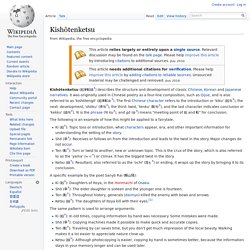
Describes the structure and development of classic Chinese, Korean and Japanese narratives. It was originally used in Chinese poetry as a four-line composition, such as Qijue, and is also referred to as 'kishōtengō' (起承転合?). The first Chinese character refers to the introduction or 'kiku' (起句?) , the next: development, 'shōku' (承句?) , the third: twist, 'tenku' (転句?) The following is an example of how this might be applied to a fairytale. Kishōtenketsu - Narrative Structures. The four basic stages of the Kishōtenketsu story structure are:1.
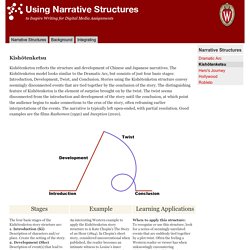
Introduction (Ki) Description of characters and/or place. Create the setting of the story.2. Development (Sho) Description of event(s) that lead to the twist. Major... Kishōtenketsu - Narrative Structures. Kishōtenketsu. Literature for Children and Young Adults. Literature for Children and Young Adults by Alita Zurav Letwin This annotated bibliography is designed to tap the rich resource of children’s literature to stimulate discussion of violence and of alternative, peaceful ways to resolve conflict.

Its focus is on books appropriate for upper elementary and middle school students, though a number of books can be used in the early elementary grades as well. These books are chosen with a number of criteria in mind. The most important is that issues of violent and nonviolent conflict resolution are clearly presented so that students can examine the following general questions: What is conflict? Using literature for this purpose can, in turn, awaken an interest in literature itself. Another criterion for selection was that, the bibliography should reflect diverse cultural experiences. The bibliography reflects the wide variety of situations in which conflict resolution and/or violence becomes an issue.
Classroom Use The Butter Battle Book. Hello! I was wondering if you have any examples of books/tv/films that play out with a Kishōtenketsu narrative? - still eating oranges. Nonviolent sff: where is it? - sciencefiction fantasy novels. Please recommend to me any science fiction/fantasy novels (maybe TV shows as well) that are well written, interesting, and essentially nonviolent.
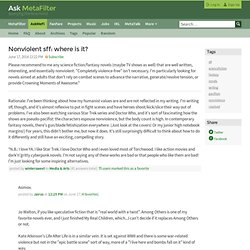
"Completely violence-free" isn't necessary. I'm particularly looking for novels aimed at adults that don't rely on combat scenes to advance the narrative, generate/resolve tension, or provide Crowning Moments of Awesome.* Rationale: I've been thinking about how my humanist values are and are not reflected in my writing. *N.B.: I love YA. Magickless: Dissecting Totoro with Kishōtenketsu. I decided to start the term with something a little more challenging for my year 7 media class.
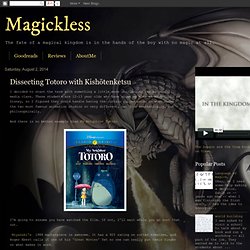
These students are 12-13 year olds who have grown up with as much Gibli as Disney, so I figured they could handle having the curtain pulled aside on what makes the two most famous animation studios so very different, not just aesthetically, but philosophically. And there is no better example than My Neighbour Totoro I'm going to assume you have watched the film. Magickless: Kishōtenketsu part 2: the trouble with Iron Man 3. My first post on Kishōtenketsu has received a fair bit of attention -- it is the second most visited page on this blog, and obviously has hit a nerve with writers and readers alike.
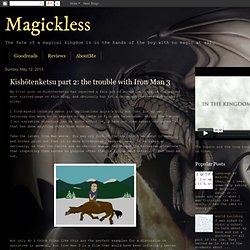
I find myself thinking about its implications quite a bit, not just for my own tetralogy but more so in regards to my taste in film and television. Whilst the typical 3 act narrative structure can be quite effective, I have not come across one recently that has done anything other than bore me. Take the latest Iron Man movie. Kishōtenketsu. You might have seen this word, Kishōtenketsu, popping up a bit in writing circles.
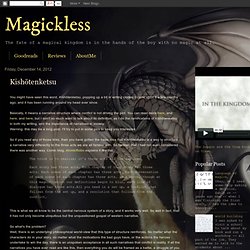
I came upon it a few months ago, and it has been running around my head ever since. Basically, it means a narrative structure where conflict is not driving the plot. You can read more here, and here, and here, but I don't so much want to talk about its definition, as I do the ramifications of Kishōtenketsu in both my writing, and the importance of narratives in society. Warning: this may be a long post. I'll try to put in some pics to keep you interested. So if you read any of those links, then you have gotten the basic idea that Kishōtenketsu is a way to structure a narrative very differently to the three acts we are all familiar with. The trick is to realize: it’s three acts all the way down. Magickless: Kishōtenketsu. On Narrative Structure: Kishōtenketsu and Obokuri-Eeumi. I've never been fond of the popularly taught three act structure (setup -> conflict -> resolution).
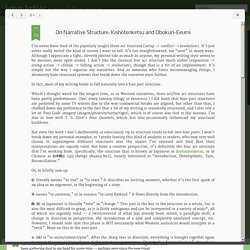
It's just never really suited the kind of stories I want to tell. It's too straightforward, too "neat" in many ways. Although I appreciate a tight, cleverly plotted tale as much as anyone, my personal writing style seems to be messier, more open-ended. Technique - Twist in kishōtenketsu vs. twist in Western plots - Writers Stack Exchange. The difference between kishoutenketsu and Western twists...
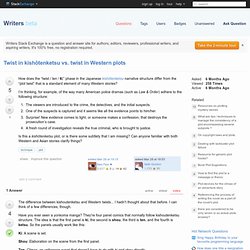
I hadn't thought about that before. I can think of a few differences, though. Have you ever seen a yonkoma manga? They're four panel comics that normally follow kishoutenketsu structure. The idea is that the first panel is ki, the second is shou, the third is ten, and the fourth is ketsu. Ki: A scene is set. Shou: Elaboration on the scene from the first panel. Kishōtenketsu. The significance of plot without conflict - still eating oranges.